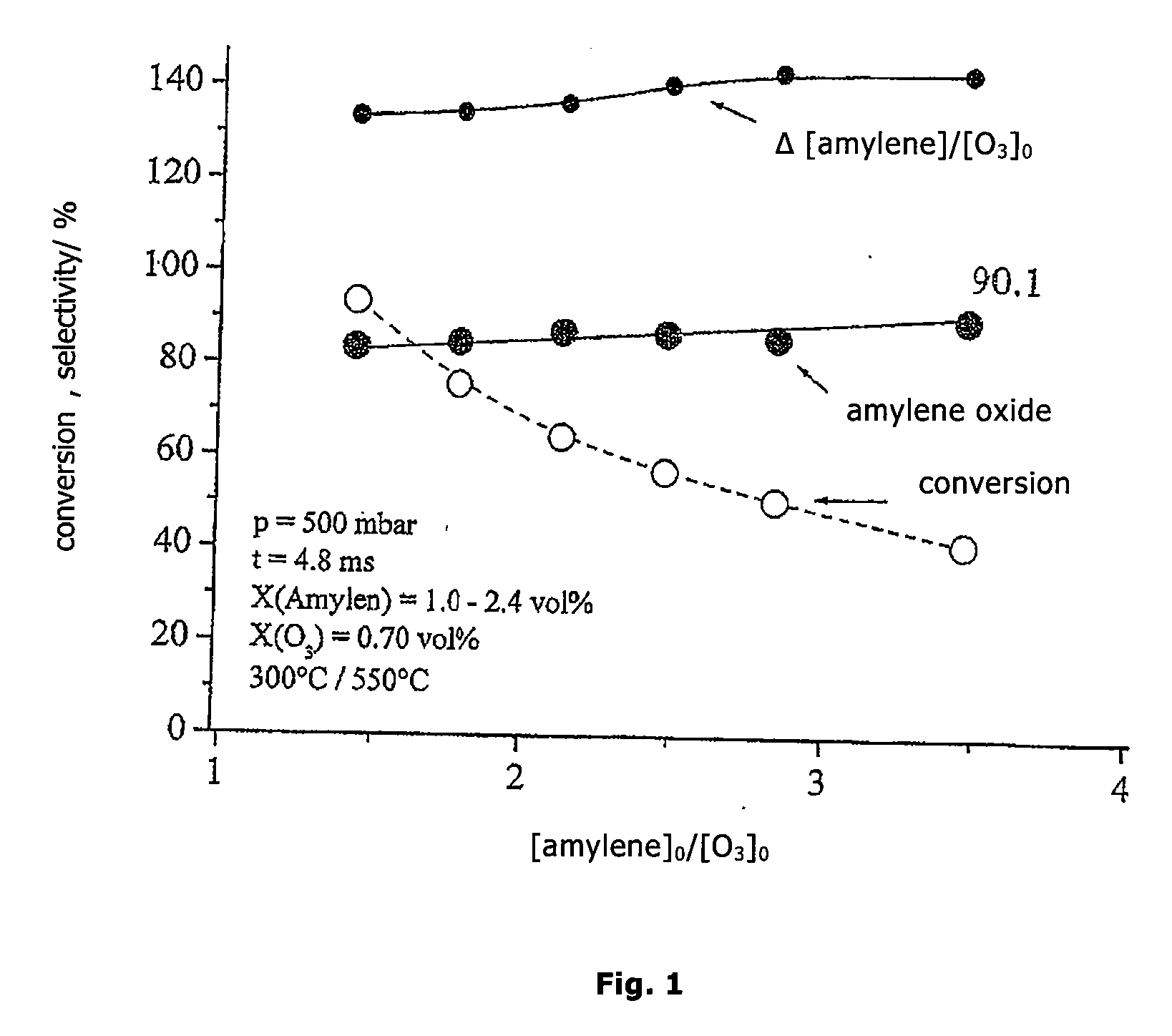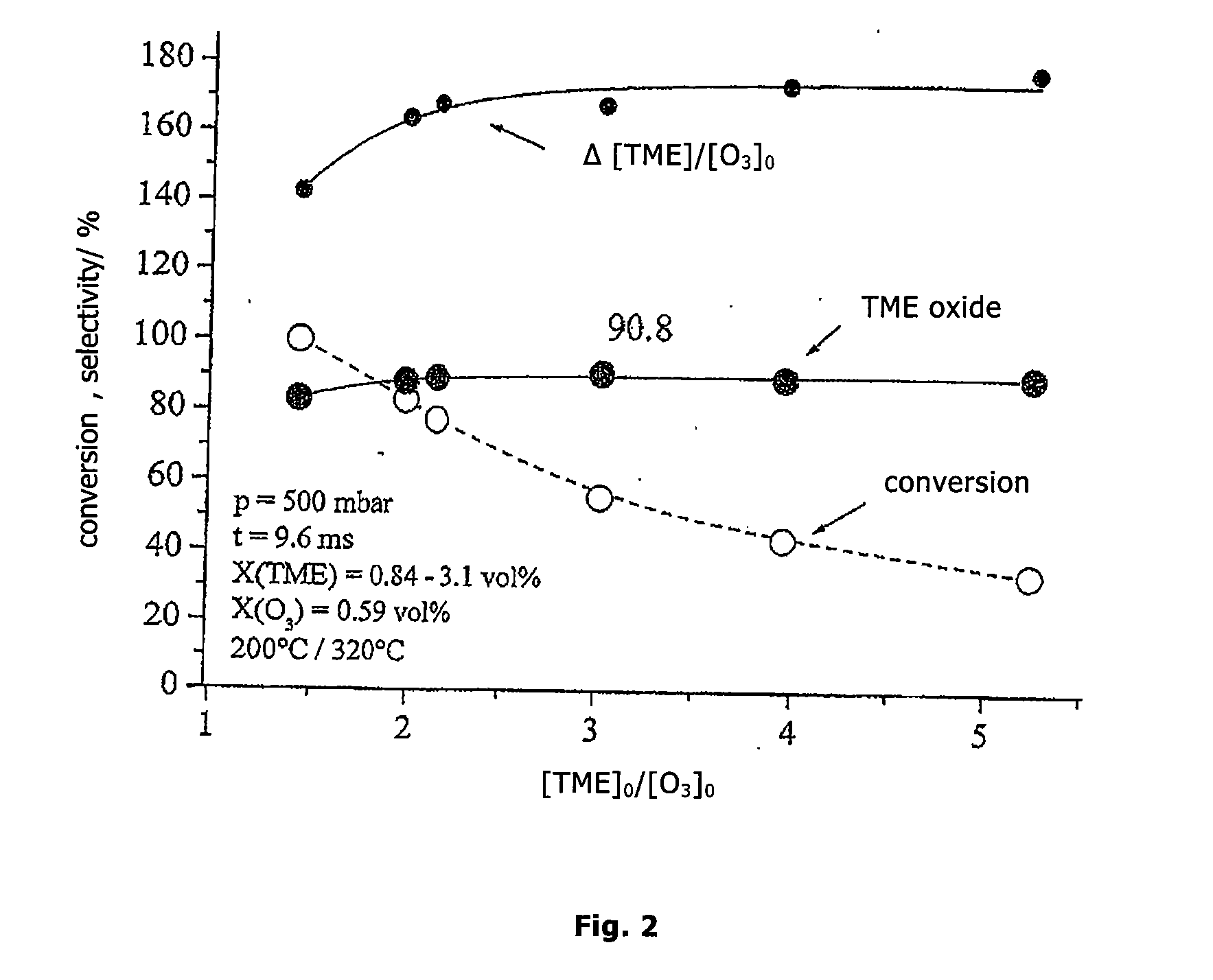Efficient process for producing epoxides by oxidation of olefins in the homogeneous gas phase
- Summary
- Abstract
- Description
- Claims
- Application Information
AI Technical Summary
Benefits of technology
Problems solved by technology
Method used
Image
Examples
example 1
Epoxidation of amylene (2-methyl-2-butene) at 300° C. and 500 mbar at Different Feed-Ratios amylene / O3 of 1.43 to 3.47
[0019]The olefin gas flow (4 standard-liter / min.) consisting of amylene and N2 is preheated to 550° C. The O3 / NOx gas flow (2 standard-liter / min.) consisting of 6.5 vol. % NO2, 36 vol. % of an O3 / O2 mixture (from ozone generator) and 57.5 vol. % N2, starting from room temperature, is brought into contact with the preheated olefin gas flow via nozzles. The reaction temperature is 300° C. After mixing, the ozone content is 0.7 vol. % and the amylene-content is 1.0 to 2.4 vol. %. The bulk-residence time in the reaction zone is 4.8 ms.
[0020]As side products, acetaldehyde and acetone are found. The results are presented in FIG. 1.
[0021]The parameters at the working point of highest selectivity at the feed ratio amylene / O3=3.47 are:[0022]conversion of amylene: 41.3%[0023]selectivity for amylene oxide: 90.1 mol. %[0024]reacted amylene / O3 employed: 1.43 (molar)[0025]space-t...
example 2
Epoxidation of TME (tetramethyl ethylene) at 200° C. and 500 mbar with Different Feed-Ratios TME / O3 of 1.43 to 5.24
[0026]The olefin gas flow (2 standard liter / min.) consisting of TME and N2 is preheated to 320° C. The O3 / NOx gas flow (1 standard liter / min.) consisting of 6 vol. % NO2, 25 vol. % of an O3 / O2 mixture (from ozone generator) and 69 vol. % N2, starting from room temperature, is brought into contact via nozzles to the preheated olefin gas flow. The reaction temperature is 200° C. After admixture, the ozone content is 0.59 vol. % and the TME content 0.84-3.1 vol. %. The bulk residence time in the reaction zone is 9.6 ms.
[0027]Acetone and pinacolone (trimethyl acetone) are found as side products. The results are presented in FIG. 2.
[0028]The parameters at the working point of highest selectivity at the feed ratio TME / O3=3.02 are:[0029]TME conversion: 55.6%[0030]selectivity for TME oxide: 90.8 mol. %[0031]converted TME / O3 employed: 1.68 (molar)[0032]space-time-yield: 3600 g ...
example 3
Epoxidation of propylene at 300° C. and 500 mbar
[0033]The olefin gas flow (4 standard liter / min.) consisting of propylene and N2 is preheated to 550° C. The O3 / NOx gas flow (2 standard liter / min.) consisting of 2.25 vol. % NO2, 10 vol. % of an O3 / O2 mixture (from ozone generator) and 87.75 vol. % N2, starting from room temperature, is brought into contact via nozzles to the preheated olefin gas flow. The reaction temperature is 300° C. After admixture, the ozone content is 0.27 vol. % and the propylene content 5.6 vol. %. The bulk-residence time in the reaction zone is 4.8 ms.
[0034]Formaldehyde and acetaldehyde are found as side products.
[0035]The parameters at the working point are:[0036]conversion of propylene: 4.6%[0037]selectivity for propylene oxide: 81.3 mol. %[0038]propylene conversion / O3 employed: 0.98 (molar)[0039]space-time-yield: 980 g propylene oxide / hr / (liter reactor volume).
PUM
 Login to View More
Login to View More Abstract
Description
Claims
Application Information
 Login to View More
Login to View More - R&D
- Intellectual Property
- Life Sciences
- Materials
- Tech Scout
- Unparalleled Data Quality
- Higher Quality Content
- 60% Fewer Hallucinations
Browse by: Latest US Patents, China's latest patents, Technical Efficacy Thesaurus, Application Domain, Technology Topic, Popular Technical Reports.
© 2025 PatSnap. All rights reserved.Legal|Privacy policy|Modern Slavery Act Transparency Statement|Sitemap|About US| Contact US: help@patsnap.com



